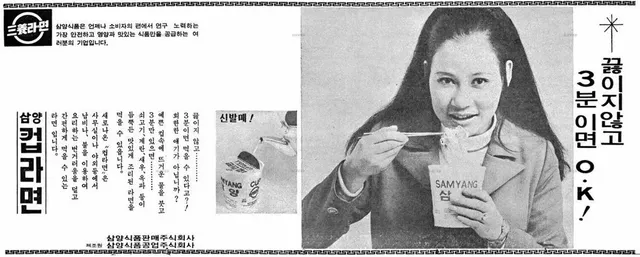Korea introduced

In Korea, Samyang Foods was the first to market it in 1972. Unlike today's expanded Styrofoam series or paper cups, it was made of thin plastic in the shape of cardboard. It was a method of making two layers of transparent plastic and inserting a paper cover between them, but later changed to a Styrofoam container because the unit price was high.
At that time, the container was larger than the smallest size of cup noodles these days and had a smaller capacity than bowl noodles. Unlike shaving bag noodles or cup noodles these days, it was flat with a rectangular cross section.It was sold with hot water only in very limited areas such as outdoor pool stores, and was rarely seen for home consumption in general stores, and the price four times higher than bag cotton was a stumbling block. In the end, it failed to catch the hearts of consumers and was discontinued shortly after.
In 1981, Nongshim Group released bowl noodles, and Samyang re-challenged the Cup Noodles (Samyang Quick 1 Cup Noodles) business, and competition in the Cup Noodles market began in earnest. In 1981, the price was 300 won, which was quite expensive since regular ramen was 100 won.
However, the ripening time was 1 minute, according to the phrase OK, and it was quickly cooked and blew up quickly. With the 1988 Seoul Olympics as an opportunity, the advantage of being able to easily eat one meal was highlighted, and the market size grew rapidly.
Until the early 1990s, vending machines serving Samyang cup noodles were located at the reserve army training grounds.
It was before and after the 1988 Seoul Olympics that cup noodles were diversified, but it was around 1994 when convenience stores became popular in Korea that they became established in people's lives in the same form as they are now. Until then, cup ramen was a special dish eaten at home, unless it was a convenience store in a bus terminal or a night job at a military base or school but LG25 (currently GS25) laid the national network, followed by the Lotte Group with the 7-Eleven brand, and the Bogwangi Family. With the introduction of the Mart (now CU), the perception that cup noodles are a convenience food eaten at convenience stores has become established among the people.